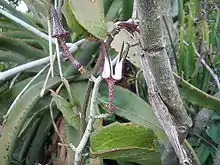Ceropegia stapeliiformis
Ceropegia stapeliiformis is a flowering plant in the genus Ceropegia (Apocynaceae), native to South Africa and Swaziland. Common names include serpent ceropegia, snake creeper, and slangkambro.
| Ceropegia stapeliiformis | |
|---|---|
 | |
| Ceropegia stapeliiformis subsp. serpentina in the wild, Ingwavuma, South Africa | |
| Scientific classification | |
| Kingdom: | Plantae |
| Clade: | Tracheophytes |
| Clade: | Angiosperms |
| Clade: | Eudicots |
| Clade: | Asterids |
| Order: | Gentianales |
| Family: | Apocynaceae |
| Genus: | Ceropegia |
| Species: | C. stapeliiformis |
| Binomial name | |
| Ceropegia stapeliiformis | |
Ceropegia stapeliiformis is a prostrate, creeping, trailing or climbing succulent creeper with fibrous roots (which develop where the stems touch the ground) and has clear sap. The leaves are minute and rudimentary, soon falling off the stems. The flowers are 5–7 cm long and have a distinctive funnel-shape with a greenish white colour that is spotted or streaked with maroon. The petals surrounding the mouth are free-spreading, reflexed and fringed with hairs. The fruit a follicle with tubercles. This species is usually found rooted in leaf mould under the protection of shrubs.
Two subspecies have been described:
- Ceropegia stapeliiformis subsp. stapeliiformis
- Ceropegia stapeliiformis subsp. serpentina (E.A.Bruce) R.A.Dyer
The subspecies stapeliiformis is known from areas of karroid scrub in the Eastern Cape province of South Africa, with a distribution from Uitenhage and Willowmore to Graaff Reinet and King William's Town. This subspecies is known to flower from October to March.
The subspecies serpentina, which was initially described as Ceropegia serpentina by E. A. Bruce, has a distribution which ranges from Northern KwaZulu-Natal and Swaziland to Gauteng, Mpumalanga and Limpopo provinces of South Africa, where it occurs in scrub bush. The flowering time from December to March.
The names have the derivations stapeliiformis = resembling Stapelia (Latin), and sepentina = serpentine (Latin).
References
- "Ceropegia serpentina". Germplasm Resources Information Network (GRIN). Agricultural Research Service (ARS), United States Department of Agriculture (USDA). (treats as a distinct species)
- Dyer, R.A. 1983. Ceropegia, Brachystelma and Riocreuxia in Southern Africa. A.A. Balkema, Rotterdam.
- Herbert F. J. Huber: Revision of the genus Ceropegia. In: Memórias da Sociedade Broteriana, Volume 12, 1957, S.1-203, Coimbra